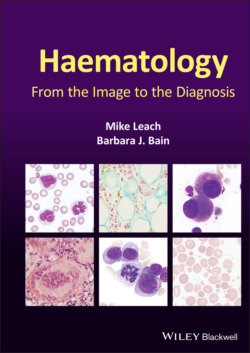Читать книгу Haematology - Barbara J. Bain, Irene Roberts - Страница 33
Оглавление24 Stomatocytic red cell disorders
A 30‐year‐old woman, born in the Philippines, presented at the booking clinic with a pregnancy of 12 weeks’ duration. She gave no prior history of anaemia or blood disorder. Her full blood count showed Hb 130 g/l, WBC 9 × 109/l and platelets 247 × 109/l. The blood film showed prominent ovalocytes, many of which were also macrocytic and stomatocytic. Notably, there were double, transverse and longitudinal stomas (left images ×100 objective) and some cells had Y‐shaped stomas (bottom left). The morphological features here, in particular the macro‐ovalocytes with double stomas (knizocytes, image top left) together with the ethnic origin of the patient, are indicative of a diagnosis of Southeast Asian ovalocytosis. This condition results from mutations in the SLC4A1 gene resulting in a variant band 3 protein which increases membrane stiffness. In the resting state there is normally minimal or absent haemolysis but this can be significant in the perinatal period. Carriers of this polymorphism have a survival advantage against all forms of malaria.
A second patient, a 37‐year‐old man, was referred for investigation of mild chronic thrombocytopenia; the full blood count showed Hb 140 g/l, WBC 5 × 109/l and platelets 80 × 109/l. There was no personal or family bleeding history and clinical examination was normal. The blood film showed prominent stomatocytes and macrothrombocytopenia but no neutrophil inclusions were present (centre images ×100). Routine biochemistry and serum lipid levels were normal. Serum phytosterol levels, however, were grossly elevated at up to 20 times the upper limit of normal. He was a compound heterozygote for mutations in the ABCG5 gene and these findings are in keeping with a diagnosis of hereditary phytosterolaemia, also known as sitosterolaemia. This is an under‐recognised disorder of plant lipid (phytosterol) absorption and excretion characterised by red cell stomatocytosis, macrothrombocytopenia and sometimes a mild haemolytic anaemia with splenomegaly. It is an important condition to be aware of as it can lead to abnormal lipid deposition in tissues (xanthelasma and xanthomas) and in blood vessels, leading to accelerated atherosclerosis. Patients may benefit from treatment with ezetimibe, which blocks absorption of phytosterols and may protect patients from the aforementioned complications.
A third patient, a 60‐year‐old man with a historical diagnosis of hereditary spherocytosis treated with splenectomy at 18 years of age after an episode of parvovirus‐induced red cell aplasia, was referred for reassessment after developing life‐threatening pulmonary embolism following a long‐haul flight. His full blood count showed Hb 140 g/l, WBC 13 × 109/l and platelets 507 × 109/l. There was no personal or family history of thrombosis and physical examination was normal. There was no laboratory evidence of an inherited thrombophilia and no molecular evidence of a myeloproliferative neoplasm. His blood film showed well‐haemoglobinised red cells with prominent stomatocytes in addition to hyposplenic features (right images ×100). His historical pre‐splenectomy osmotic fragility test was traced and found to be normal as were red cell eosin‐5‐maleimide (EMA) binding studies by flow cytometry. Red cell membrane polyacrylamide gel electrophoresis showed no abnormality. The features here are in keeping with a diagnosis of overhydrated hereditary stomatocytosis, a mild, often well‐compensated haemolytic anaemia most often caused by mutations in the RHAG gene that result in loss of membrane stomatin, causing abnormal sodium and potassium homeostasis and increased intracellular water. Splenectomy significantly increases the risk of venous thrombosis; the patient is now on life‐long anticoagulation with rivaroxaban.
MCQ
1 Stomatocytosis can be a feature of:Alcoholic excess and alcoholic liver diseaseHereditary xerocytosisHydroxycarbamide therapyTriose phosphate isomerase deficiencyZieve syndromeFor answers and discussion, see page 206.
